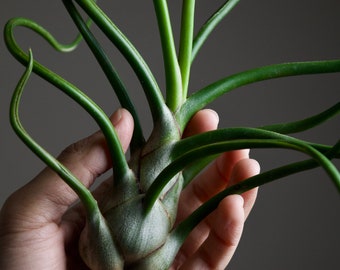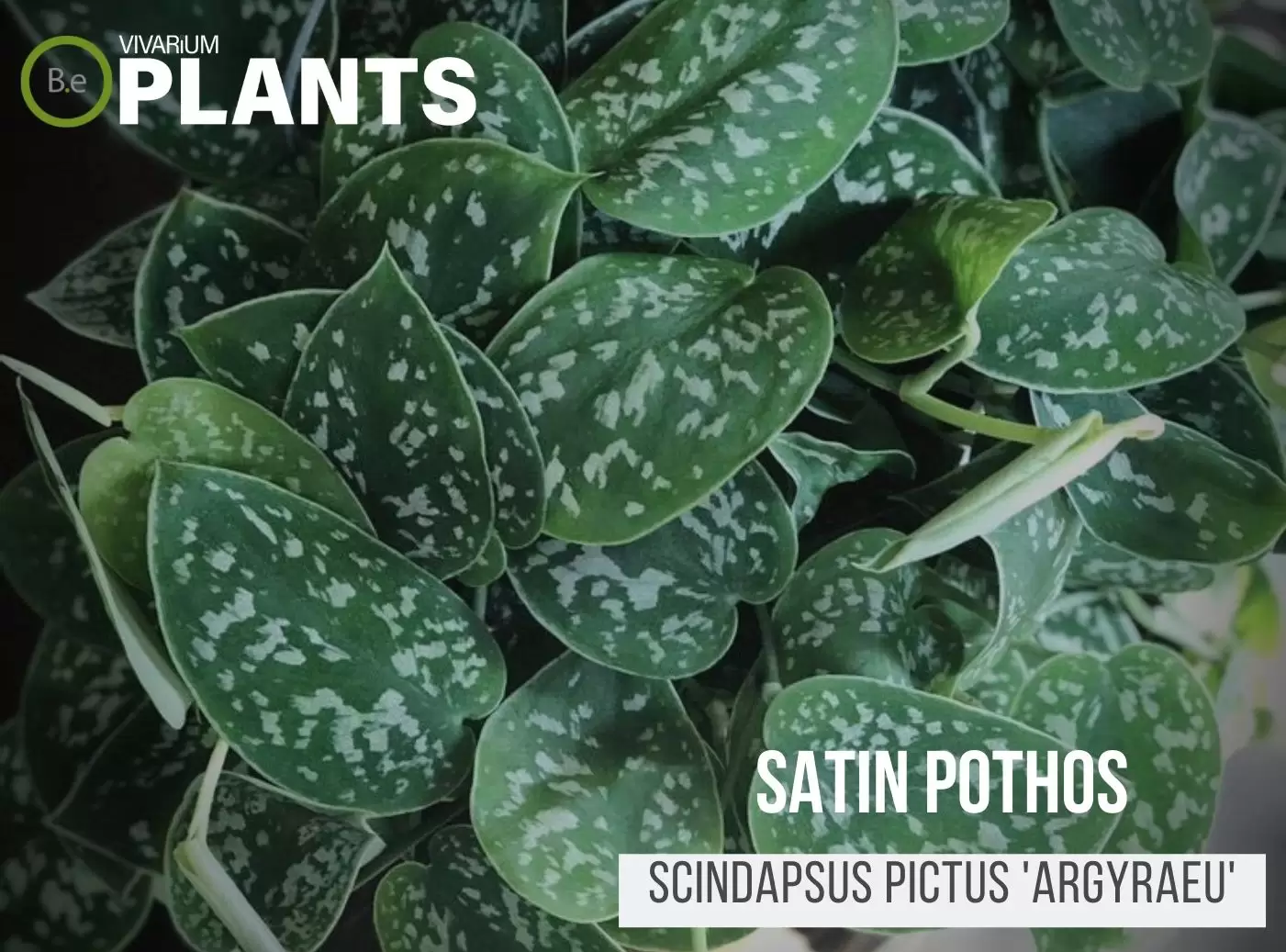Tillandsia bulbosa is an epiphyte plant that is perfect for almost any vivarium and makes an excellent accent plant in any enclosure.
This species of tillandsia is great for all levels of hobbyists alike and is a hardy species of air plant.
They are peculiar and unique from other plants, as they have a bulbous, almost alien-like look!
This makes them a great choice for hobbyists that want something curious and interesting to add to their enclosures.
| Quick Stats: | |
|---|---|
| Scientific Name | Tillandsia bulbosa |
| Common Name | Bulbous Air Plant |
| Family Name | Bromeliaceae |
| Habitat | Tropical and Subtropical Regions |
| Temperature | 65°F to 85°F |
| Height | 1 to 4 inches |
| pH | 6.0 to 7.5 |
| Lighting | Moderate |
Table Of Contents:
ToggleWhat is Bulbous Air Plant?
Tillandsia bulbosa can range in clumping size, but in a vivarium, they are usually small and compact without growing too large.
They have an alienesque look which has gained them the nickname “the alien plant,” as their bulbous form makes them look almost extraterrestrial!
Realistically, they are epiphytic plants, meaning they only make use of their shallow root system to cling onto the substrate and other hardscapes rather than to absorb nutrients like most other terrestrial plants.


Bulbous Air Plant Facts
Tillandsia bulbosa is a rather interesting plant with a unique appearance that is often overlooked for vivariums due to its size!
It is an epiphyte, meaning that its root system does not take in nutrients from the soil like a normal plant.
Instead, it is used as an anchor to effectively attach itself to another object like rocks or driftwood.
It also has an otherworldly look with its bulbous form and colorful leafy tips.
Description
A bulbous air plant is a relatively small plant with a unique bulbous shape, which is created due to its tightly packed organic material.
This organic material is significantly more dense than most other epiphytic plants and can range in color depending on the health of the plant. Coloration could range somewhere between green, yellow, orange, red and even purple.
Another distinctive feature of this species is its ‘balloon’ tentacle-like outgrowths that grow from its growth point.
Habitat
Bulbous air plant is native to tropical and subtropical regions including Mexico, Central America, Colombia, and Costa Rica.
In the wild, they generally thrive in hot and humid areas while never submerged in water.
This species of air plant is hardy and survives in the less-than-ideal conditions you find in vivariums.
pH Preference
When it comes to bulbous air plants and pH preference: it is best to keep the pH between 6.0 – 7.5.
Vivarium Type
The bulbous air plant is quite an easy-going species.
With that in mind, it will not be too complicated when it comes to choosing the type of enclosure it is grown in.
It is best to try and replicate the plant’s natural habitat as much as possible.
Doing so will make it easier to provide this air plant with its basic needs.
The proper setup and theme of the enclosure will make a big difference to the overall look and health of the plant.
Be sure to choose setups that are moist and high in humidity.
Here are recommended vivariums it will do well in:
- Paludariums – Half aquatic/ half terrain-based enclosure.
- Terrariums – Fully terrain-based enclosures with little to no aquatic features.
Vivarium Placement
In order to get the most out of your Tillandsia bulbosa, placing it in an area that receives a moderate level of light is the best.
Too much light will scorch the leaves and too little will give you non-existent growth.
Substrate
Tillandsia bulbosa is a type of air plant which means it does not require a typical soil medium that terrestrial plants need.
Generally, a piece of driftwood or stone is enough substrate to attach itself to.
Your substrate should be lightweight and well-drained, but moist enough to promote root growth.
Lighting
Tillandsia bulbosa will still need lighting just like any other plant.
Placing it in a moderate amount of light is good, as it will promote its growth and overall health.
Too much light can scorch the leaves and too little will result in zero growth.
A good equivalent would be an equivalent of high-wattage fluorescent or LED in an ideal environment.
Buy Bulbous Air Plant
When it comes to buying bulbous air plants, there are a few things to keep in mind.
Making sure the plant is healthy when purchased is essential for its success in a vivarium.
Vegetation that is already in poor conditions will have a very hard time adjusting to new environments.
Always make sure to buy from a reliable and honest establishment.
Click the image below to find out more about the current price and other relative info about this plant.
Bulbous Air Plant Care and Propagation
Tillandsia bulbosa is an easy and reliable species of air plant that doesn’t require a lot of maintenance.
The most time-consuming task when it comes to dealing with this species is the light it requires.
One should keep in mind that too much or too less light can have negative consequences on its growth.
How to Grow
To propagate bulbous air plants, simply remove any bulbs and replant them in the substrate.
Over time, the new bulbs will eventually grow into the full-sized plant as long as it has a steady supply of moisture and light.
Watering
Tillandsia bulbosa needs to be watered so it can adequately absorb nutrients and air.
However, it should not be submerged in water as this will decrease its air supply.
The best way to provide your tillandsia with the moisture it needs is with a spray bottle: approximately 1-2 times per week should suffice.
Plants Similar to Bulbous Air Plant
Adding diversity to an enclosure is key to an aesthetically pleasing setup.
Try mixing up the look of your vivarium with different flora that can easily co-exist in the same types of environment.
Furthermore, if you find bulbous air plants hard to acquire or would like to consider something similar to this plant…
Here are other plants you might find will do well with or in the place of Tillandsia bulbosa:
Conclusion
In conclusion, Tillandsia bulbosa is an interesting and beautiful plant that is perfect for any vivarium.
It is a hardy species of air plant that can withstand a variety of conditions and will provide your vivarium with character and charm.
Just make sure to provide your Tillandsia bulbosa with enough water and light and it will reward you with growth.
Frequently Asked Questions
Caring for Tillandsia Bulbosa
1. Place your Tillandsia Bulbosa in a bright, indirect light.
2. Allow the plant to dry out between watering, typically every one to two weeks.
3. Mist the plant 1–2 times weekly with distilled water or rainwater to keep it hydrated.
4. Give your Tillandsia Bulbosa a light fertilizer once a month during the growing season. (BONUS)
5. Prune your Tillandsia Bulbosa in the spring to remove old leaves and help it stay bushy.
6. If planted, repot your Tillandsia Bulbosa every one to two years in light and airy potting soil.




